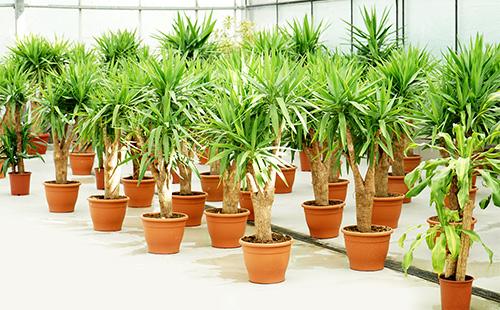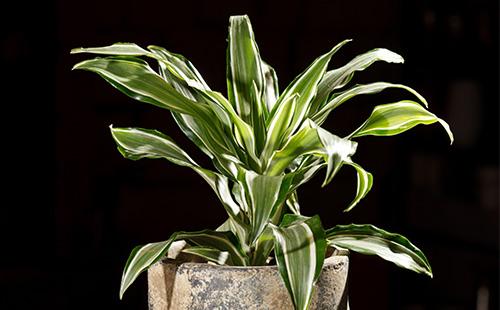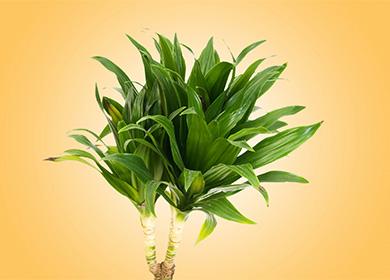The content of the article
A beautiful legend explains the appearance of the first “tree of happiness”, as they call the dracaena in America. The legend speaks of a brave young man who fell in love with the daughter of a leader of another tribe. The bride’s father set the condition: the wedding will take place only if the stick, stuck by the young man in the ground, gives leaves no later than the fifth day. Seeing the blossoming greenery, the leader blessed the lovers. Since then, dracaena is considered a symbol of love and matrimony.
Popular views
In nature, plants of this species can reach 18 m in height, but at home they remain much smaller. Botanists know dozens of types of dracaena, but for apartments most often only some of them are purchased.
- Dracaena Bordered. The leaves of this variety are long and narrow, resembling a disheveled hairstyle. All greens are concentrated in the upper part of the trunk. After the leaves fall, a recognizable pattern remains on the table. This type of "tree of happiness" with proper care and a large volume of soil can grow up to 3 m.
- Dracaena Dermskaya. It is easy to identify by the original color of the leaves: they are decorated with white stripes of various widths along the entire length. This species develops more slowly than others, reaching in adulthood up to 1.5 m in height. Leaves can have a color from bright green to light green with stripes of lighter tones. During flowering, an unpleasant, pungent odor is released.
- Dracaena Sander. This species is often confused with bamboo due to the similarity of the trunks and leaves of the two plants. However, dracaena reaches much smaller sizes - only up to 1 m. Most often, the trunks of this variety are artificially shaped into bizarre shapes, which makes the plant a welcome guest in apartments and offices. The oblong, slightly twisted leaves of such dracaena have an olive hue.
- Dracaena is fragrant. The leaves are narrow, long, with grayish-silver longitudinal stripes. A distinctive feature of the species is almost constant flowering, even with a decrease in temperature. Fragrant dracaena flowers give off a pleasant aroma. The view is capable of reaching two meters in height.
- Dracaena Unbent. This species needs high humidity. The leaves have a deep green color with wide edges on the edges. The stem branches over the entire height, the leaves bend to the ground, unbending from the trunk.
- Dracaena Godsef. The appearance of this plant does not allow to suspect belonging to the species: the leaves are wide, short, ovate, the plant is bushy, does not exceed 70 cm in height. Leaves can be beige, greenish, emerald with specks of golden or cream shades. Abundantly and often blooms.
- Dracaena Draco (dragon). In nature, the trunk reaches 25 m in height and 5 m in diameter, but the apartment does not exceed a meter and a half. Experts call this species a “false palm tree" because of the strong external resemblance. The leaves are long, narrow, xiphoid, with a reddish edge.
Dracaena: care and favorable conditions
When choosing a dracaena, it is necessary to remember that its various species can reach different heights. It is necessary to decide in advance whether the giant dracaena will fit in the house or whether it is better to limit itself to the “version for the windowsill”. When purchasing a plant with variegated leaves, keep in mind that it will need additional lighting with LED or fluorescent lamps. What else should be envisaged in caring for the "tree of happiness"?
Lighting
Although dracaena is a tropical plant, she does not like direct sunlight. It should be positioned so that the light is scattered. The best place for a pot with dracaena is the east or west side of the room. If it is impossible to remove the plant from the sunny side, create an artificial shadow for it so that the leaves do not burn. Monochrome leaves require less light than variegated, for which light is a source of color saturation.
Temperature
Most varieties of dracaena prefer a moderate temperature: 24 ° C in the warm season and at least 15 ° C in the cold. However, some species do not stop flowering even if the temperature drops to 10 ° C. Care should be taken to ensure that the flower does not get in the way of a draft, which can cause a serious illness or even death of the plant.

Watering
Dracaena will tolerate enough moisture deficiency, however, for its excellent health, you should still carefully monitor the moisture of the soil. So, if the upper 2-2.5 cm of soil has dried, good watering is required. If the earth remains damp even after a couple of days, you should wait with moisture. On average, in summer you should water the dracaena twice a week, in winter - once every seven days.
In addition to watering, you need to take care of the leaves - a “tree of happiness” will be grateful for regular spraying from the spray bottle. Water should be at room temperature, soft.
Fertilizer
Caring for home dracaena in a pot involves the use of fertilizers. In order for top dressing to give the desired result, you must correctly select the ratio of components or purchase mixtures created for ficus or deciduous ornamental plants.
Top dressing is carried out in the warm season, mainly from April to September. Fertilizing is recommended every 14 days. In addition to ready-made mixtures, it is recommended to use homemade products that can have a beneficial effect on the growth of dracaena. So, monthly use of nettle tincture is popular.
Plant transplant
Many beginner gardeners do not quite understand how to care for dracaena after purchase. First of all, the question of the need for a transplant is of concern. Experts believe that a young plant can be transplanted immediately after purchase, regardless of the season, while a large flower should be left alone until spring.
Before transplanting, it is necessary to prepare the soil and the pot. The pot should match the size of the root system and the height of the plant. So, for a half-meter flower, a pot with a height of about 20 cm is enough. There is no need to plant a dracaena immediately in a large flowerpot, since it is necessary to transplant the plant at least once every two years. It is enough to purchase a pot exceeding the previous one by 3-4 cm in diameter. Transplanting into a container of a much larger size will lead to stagnation of water and rotting of the roots.
Soil for dracaena can be purchased at the store or made independently.For "home-made" soil, it is necessary to mix the following types of soils in a ratio of 1: 0.5: 1: 2:
- compost;
- peat;
- sheet earth;
- turf.
After preparing the container for transplant and filler, you need to perform seven simple steps.
- Pour boiling water over a new pot.
- Place a drainage layer at the bottom.
- Get dracaena from an old pot and carefully examine the roots. (If rotting parts are found, they are cut off).
- Spray the root system with spray water.
- Place the plant in a new container, pour in the soil.
- Make sure that there are no air pockets between the roots, carefully scattering the ground between the roots.
- Pour dracaena with fertilizer water.

Dracaena propagation
Sooner or later, gardeners have a desire to propagate the "false palm" -
dracaena. If the care of the dracaena flower was carried out correctly and the plant is healthy - there can be no obstacles to home breeding. Three methods are suitable for propagating dracaena.
Seeds
This method is only for species that have a green leaf. Before planting, the seeds are soaked in a stimulant solution ("EPIN", "SILK" or the like) that stimulates growth. It is important that the air temperature does not fall below 29 ° C. Dracaena seeds are planted in a small container filled with soil made up of turf and sand 1: 1. If turf is not available, peat can be used. From above it is necessary to pull a film or tightly cover with a transparent cover. If the maintenance temperature and soil are correct, shoots will appear in a few months.
Cuttings
Cuttings are made in the presence of a healthy young stem. With a sharp knife, it is necessary to cut the trunk into cuttings 4-6 cm long. You must act carefully so as not to wrinkle the delicate stalk. Each stalk must be cut from one end and inserted into the soil prepared in advance with the same end. The container with cuttings should be placed in a warm place, avoiding direct sunlight. After a few months, shoots will appear, which must be sprayed from the spray bottle with room temperature water.
Layering
Growing dracaena from the appendix at home is not a troublesome matter, but requires patience. For this method, it is necessary to cut off the top of a healthy plant and put it in a container of water, into which activated carbon is added. The process of root formation is slow - this requires at least three months. Only after the appearance of thick, durable roots can dracaena be transplanted into the ground. The same method of reproduction is used if the dracaena was trimmed.
How, when and why crop
Trimming the dracaena for branching is easy and this does no harm to the plant. In addition, the resulting layering can be used for reproduction. The optimal period for trimming dracaena is from early March to early June. Trimming is a plant that has reached at least 30 cm in height. If a plant that has lost a significant part of the lower leaves is cut, it is better to cut it below the remaining leaves by 5 cm. Cutting a healthy, green plant is done at the request of the owner.
You need to understand that pruning leads to the fact that the main stem will retain its original height - it will not grow anymore. If dracaena withers and discards leaves, it is better to cut it. Several new crown tops soon form at the cut site, making the plant denser. The slice should be sprinkled with crushed coal. If there are several trunks, it is better to cut them at different levels, so that then they do not obscure each other.You can avoid further dropping of leaves by placing a pot with a plant so that all leaves get the same amount of light.
The main pests and how to get rid of them
Dracaena attracts some pests that can cause serious damage to it. Interestingly, the main reason for the appearance of parasites is the incorrect content of the flower or neglect of the rules of care. In order to save dracaena from death, it is important to recognize pests in a timely manner and get rid of them.
- Shield. Lives on the trunk and leaves, very quickly infects the entire plant. As a result, the leaves turn yellow, growth slows down significantly. If treatment is not started as soon as possible, the death of dracaena is inevitable. In this case, it is not difficult to get rid of the parasite: in case of a weak lesion, it is enough to wash the leaves with soap and water with the addition of alcohol. To do this, dissolve a tablespoon of detergent and 100 ml of vodka in a liter of water. If there are too many pests, you should treat the plant with Actellic, which is best used outdoors, taking measures to protect the respiratory tract.
- Thrips. These are very small black insects that settle on the leaves. You can detect them in the tracks: when moving, the pest leaves silver stains. As a result of thrips, the growth of dracaena slows down, spots appear on the leaves. To destroy the parasite, it is necessary to treat the leaves with soapy water (1 tablespoon of detergent per liter of water) or foam soap. Wash off in the shower after 24 hours. If this procedure does not help, treatment should be performed a second time.
- Spider mite. This pest settles on the leaves, which makes them yellow and dry. Most often, the tick affects plants in dry air. According to reviews, to destroy the parasite, it is enough to increase the humidity level in the room, regularly spray dracaena with warm water or chemicals from ticks.
Signs of illness
Sometimes even in the most careful hosts the flower loses its color, the tips of the leaves dry, the foliage flies around, the growth of the plant slows down and other unpleasant changes occur. First of all, you need to find out the cause and only then deal with the consequences.
Leaves turn yellow
Yellow leaves in most cases are the result of errors in care. Which ones and how to fix them are described in the table.
Table - Reasons why yellow dracaena leaves turn yellow and how to help the plant
| The reason for the yellowing of the leaf | What to do |
|---|---|
| Natural aging | - Trim yellowed sections of the sheet |
| Low humidity | - Spray plants; - install a humidifier in the room |
| High soil moisture | - Get the flower out of the pot; - dry the root system; - remove rotten parts; - transplant dracaena into new soil; - avoid overflow in the future |
| Lack of moisture | - Water at least twice a week |
| Sun exposure | - Put the pot in a place where the sun cannot burn the flower; - create artificial shadow |
| Cool and draft | - Remove the pot to places inaccessible to drafts; - monitor the air temperature; - remove the flower from the windowsill in winter |

Leaves turn black
Unfortunately, this symptom most often indicates that the flower is already close to death. This symptom appears for two reasons.
- Excess moisture. Excessive watering kills the plant. When the soil is constantly waterlogged, the roots cannot get the amount of oxygen they need, as a result of which the process of decay begins.The plant, deprived of the opportunity to receive nutrients, dies: the leaves turn black and fly around, the trunk softens. In just a few days, dracaena can completely become bare.
- Temperature reduction, drafts. If most of the leaves are blackened, it will not be possible to save the plant. If the subcooling is insignificant, you should remove the pot in a warm place where the dracaena can gradually recover. In addition, if the apical cuttings are not affected, you can try to root them by cutting and placing them in a container of water. The main thing is to put these shoots in a warm place where the flower will not face further hypothermia.
The appearance of the trunk is changing
Sometimes a home palm tree looks like its trunk is wrinkled. Most often, this effect occurs as a result of overflow, when the plant tissues swell and soften. At this stage it may be too late to try to save the flower, but it is worth a try. It is necessary to transplant dracaena as soon as possible, thoroughly cleaning the root system of rotten parts. The earth is completely replaced. Watering limit.
What else is important to know
Dracaena is an unpretentious plant, however, there are some tricks in the care, without which it is difficult to grow a beautiful and healthy plant.
- The soil. The drainage layer in the pot during transplantation should be increased, since dracaena is more afraid of overflow than many other domestic flowers. In addition, it is very important in spring and summer to thoroughly loosen the upper soil layers to improve aeration.
- Watering. Watering the plant is necessary only with boiled water. In extreme cases, let it stand for two or three days.
- Neighborhood. A group of lush shrubs in a pot looks much more aesthetically pleasing than one half-naked stem, so you should plant several cuttings in one container, regularly rejuvenating plants by cutting the top.
- Transfer. If the thickets have turned out to be too thick, you should properly plant the dracaena, carefully separating the roots during a regular transplant. During the transplant, it is worth enriching the soil with sand, birch charcoal and expanded clay.
- Plaque. If a white coating on the ground is visible in the pot, the latter should be replaced with a fresh one.
The tree of happiness is a beautiful and elegant plant that can create the atmosphere of the tropics in the room. Proper care of home dracaena in a pot, disease prevention, patience and love - this is what will give the flower strength to please the owners with its exotic look for many years.

